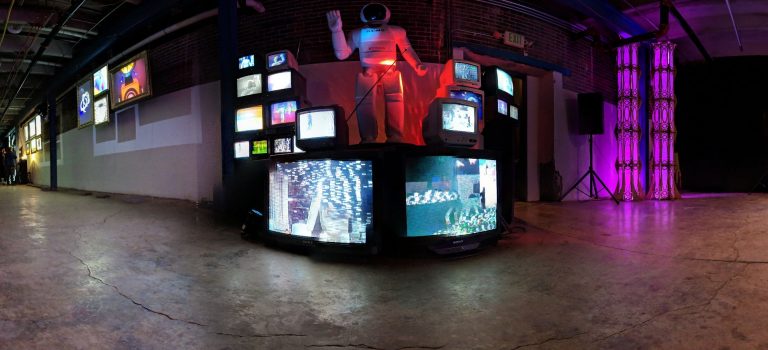Source: The Art Newspaper.
Bricks-and-mortar commercial spaces are bringing crypto art to life, “providing an experience beyond the artwork living on a cell phone”.
The frenzy around NFT art is now entering the physical realm, from CryptoPunks being displayed on billboards around Miami to a major NFT exhibition, Virtual Niche—Have you ever seen memes in the mirror?, which has just closed at the UCCA Center for Contemporary Art in Beijing. Compounding this trend, bricks-and-mortar commercial galleries specialising in non-fungible tokens are also popping up.
In March, Superchief gallery opened a New York space that is being touted as the world’s first physical NFT gallery and is currently showing 300 artists’ works on high-resolution screens, alongside NFT drops online (until 25 May).
Also in March, Atlanta’s ABV gallery collaborated with the NFT marketplace Nifty Gateway and the company Outfront Media to present Chain Reaction, showing work by crypto artists on 20 digital displays within the gallery and across various public displays in Atlanta and Boston.
In Denver, the grassroots art cooperative IRL Art worked with the curator Robert Gray, who founded the Black Love Mural Festival, to mount The Black Love Art & Crypto Gallery (The B.L.A.C. Gallery) at the Art Place in RiNo Arts District in February and March, featuring over 30 Black artists. The show is also on display on Cryptovoxels, with artworks on Unique.One.
And in Germany, the writer, artist and dealer Kenny Schachter, a vocal proponent of NFTs, is curating a show, Breadcrumbs, at Galerie Nagel Draxler in Cologne (12 May until 19 June), showcasing a group of early and present non-fungible adopters, with the aim of exploring what NFTs really mean for both digital and physical art.
Yet, Galerie Nagel Draxel co-owner Saskia Draxler says, “it should already be clear that when you look at art history, after Warhol, Polke, Richter, the next to come is not Beeple. And NFTs will not replace physical art any more than NFTs from a Nike sneaker will replace real sneakers.”
It may seem a very 2021 phenomenon, but industry experts such as Martha Buskirk, author of Creative Enterprise: Contemporary Art between Museum and Marketplace, say the notion of digital art being displayed in real life is not new: “There’s a long history of digital art being displayed in galleries or museums, even when its primary existence is online. The desire to show NFTs in physical sites is therefore not surprising, even though it seems profoundly contradictory.”
Justin Aversano, an NFT proponent and photographer, agrees: “Nothing has changed in the forms of art that is being displayed; such as on screens or projections. The only shift that is occurring is in the financial infrastructure on processing payments through the blockchain to purchase NFTs,” he says.
In fact, Annie Phillips, the art director of IRL Art, and her team, have been creating physical gallery spaces in the blockchain community since 2019 in partnership with ETHDenver, even selling Beeple’s first two NFTs in a physical show in February 2020.
However, Edward Zipco, Superchief’s gallery director, thinks “one aspect of the [NFT] market that was severely lacking was physical presentation.” He believes it is crucial to show the work of art at “full resolution, as the artist intended, and providing an experience beyond the artwork living on a cell phone,” while also showing potential collectors what it looks like to actually live with digital art.
The gallery, which accepts payment in crypto currency, reportedly sold $150,000 of art in its first week. Sales figures aside, perhaps the most interesting efforts to hybridise NFTs are those focused on promoting inclusiveness in what can be a very white-male sphere.
NFTs remain problematic, however, dogged by issues such as fraud and their harmful ecological impact. And Superchief Gallery has also been accused of worker exploitation in the past, something that has been raised in recent conversations on the audio-only social media platform Clubhouse. An article in Jezebel in 2019, which interviewed a dozen former and current Superchief employees, claimed that the “gallery’s hyped reputation has only been made possible through labor practices that they allege are illegal, unethical, and unsafe”.
In response to the article, Zipco tells The Art Newspaper: “When Superchief Gallery opened in 2012 it was a DIY, artist run gallery working with our community on art exhibitions, very much as a labor of love…It was a strange thing, growing up in public, from a community gallery with friends working together to a nationwide arts organisation where it was no longer ok to let artist friends volunteer on projects—but we took that moment back in 2019 really seriously and made the fundamental changes to systemically correct that and that growth has continued to level us up.”









